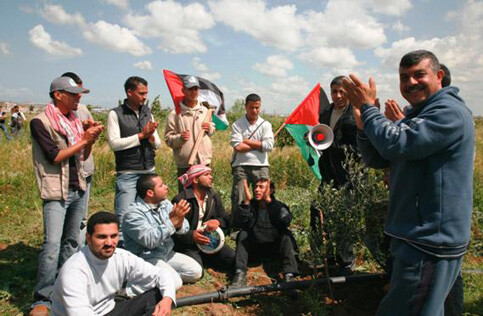Palestinian Center for Human Rights 3 April 2009

Jamal al-Bassyuni (far right) and local activists from Beit Hanoun celebrate Land Day. (Sarah Malian/PCHR)
As farmer Jamal al-Bassyuni plucked a stalk of ripening wheat, a posse of young men danced in his field. The dancers were flanked by a lively crowd, many of them women wearing the traditional Palestinian embroidered thob dress. Despite the nearby rubble of destroyed houses, and tracts of land laid to waste by bulldozers and tanks, the mood was defiantly sunny. Local farmers and their supporters were celebrating Palestinian Land Day.
Land Day was launched in 1976, as a commemoration of the deaths of six Palestinian citizens of northern Israel killed by the Israeli military as they demonstrated against expropriation of their land. It has become an important symbolic day of action across the Occupied Palestinian Territories, highlighting the plight faced by farmers like Jamal al-Bassyuni and his family, who live in Ezbat Beit Hanoun on the northern edge of the Gaza Strip.
“I have worked on this land with my brothers for sixteen years” says Jamal. His family owns 360 dunams (a dunam is the equivalent of 1,000 square meters) of land that stretch right up to the infamous Erez border crossing.
“If you had visited here even ten years ago you would have seen why we love this land so much. There were trees everywhere: we had apple, orange and lemon trees, and we grew olives, grapes, pears, almonds, pomegranates, dates and mirabella plums. Beit Hanoun was a garden.”
Local farmers across Ezbat Beit Hanoun were renowned for their citrus fruits, especially the orange trees whose blossom famously perfumed the air. But these days there is only a smattering of fruit trees left. Since the beginning of the second intifada in September 2000, Israeli bulldozers and tanks have destroyed more than 42,000 dunams of agricultural land in the Gaza Strip, the vast majority of it in border areas like Ezbat Beit Hanoun and the farmland in the eastern Gaza Strip.
Jamal says his land has been bulldozed many times. “When our trees were first destroyed in 2002 we replanted them” he says. “But our land was bulldozed again in 2003, then 2004, and the following years as well. Every time we replanted, the bulldozers would come back and destroy our work again. We had been living here for a long time, but the Israelis finally drove us off our own land.”
After years of Israeli incursions onto their land, the al-Bassyuni family eventually left their farmhouse and moved to a house on the edge of nearby Beit Hanoun town. They worked on their land during daylight hours, and employed a local man, 36-year-old Mousa Mohamed al-Jeraitli, to guard the farmhouse at night. On 5 January 2009, Mousa al-Jeraitli and his family were inside the farmhouse when it was struck by an Israeli projectile. Mousa was killed and one of his sons was injured in the attack. The farmhouse was also destroyed.
During the recent military offensive in Gaza more than 14,000 homes were destroyed or damaged and several thousand more dunams of land were ravaged by tanks and bulldozers. The scale of destruction of land and civilian property across Gaza indicates Israel’s intention to systematically destroy Palestinian homes and their livelihoods.
Farmers across the Gaza Strip, especially those living in border areas, continue to face danger if they attempt to work their own land. Israel’s unilaterally-declared “buffer zone” of 350 meters inside Gaza’s borders has continually been expanded by Israeli military incursions, and farmers living more than a kilometer from the border have had their fields destroyed. Farmers report being shot at by Israeli soldiers as they try to plant or harvest their crops and the border areas are gradually being emptied as more and more families are being driven from their own land.
As the dancers stamp and cheer for the land, Jamal al-Bassyuni points to the ruins of his former home. “All the years we lived here we had no electricity” he says. “But we had our farm, and our land gives us our feeling for life. I know every inch of this land, and my family still come here every day, though we are afraid, especially after the war and what happened here. We are not growing trees here now, but we are still planting wheat and vegetables. Because in our hearts we are farmers.”
This report is part of the Palestinian Centre for Human Rights series “Aftermath” that looks at the aftermath of Israel’s 22-day offensive on the Gaza Strip, and the ongoing impact it is having on the civilian population.
Related Links